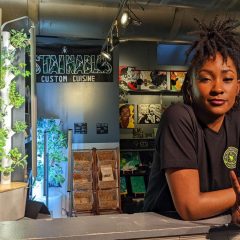Post by Andrea Kirsh

Tapirapé: Upé mask. Worn during the celebration of the spirits of the dead ceremony. H: 106.5 cm L: 132cm. Photo Ó Houston Museum of Natural Science.
One of the most splendid exhibitions in Philadelphia is hiding much too quietly at the University of Pennsylvania Museum of Archaeology and Anthropology, under the low-key if not boring title, “Vanishing Worlds; art and ritual of Amazonia.” What you’ll find among 150 works on view are feathers, feathers and more feathers, all with the high-keyed hues of tropical birds. Philip Treacy, eat your heart out!

Philip Treacy feathered fedora
The exhibition records the mostly-ceremonial dress worn by the few remaining indigenous groups from eight regions of the Amazon. They are an endangered species; only 100,000 remain from a population estimated at 3-5 million prior to the arrival of Europeans. The exhibition is one more reminder that body adornment is man’s original art form; applying cosmetics and dressing-up for special occasions is highly traditional, and today’s tattoos have a very long lineage.

Maya Tunic. Tunics like this one were decorated with bold, geometric designs. The colorful patterns are highlighted with a stuffed toucan head attached to the front or on both sides. H: 86cm L:41cm.
These Amazonian peoples worked with what was at hand: feathers, colored seeds, shells, iridescent beetles’ wing-casings, as well as grasses and fibers for basketry. They did not strive for understatement; theirs must be some of the most splendid head-dresses ever made. Almost all the groups created feathered hats and/or other head ornamentation. They used the highly polychromed feathers of tropical birds in inventive and wondrously-varied ways. There were numerous large, horse-shoe shaped and feathered pieces described as “dorsal head-dresses” – a term new to me. After searching in the catalog for a picture of one in use, I discovered that these sit behind the head and body, forming an aureole, exactly as Mummer’s costumes do. The Ticuna also made extraordinary masks of basketry, with attached grass skirts that hid the entire body and would have shimmered when the wearer moved. This must be a universal idea wherever raffia is plentiful, since grass-skirted masks are also found in New Guinea and parts of West Africa.

Kayapó-Mekrãgnoti: Headdress, roriro ri. Worn by adult men during various ceremonies. Photo © Houston Museum of Natural Science.
While a few of the pieces were described as every-day dress, most were for ceremonial use and the most extravagant were usually worn by the shamans. I would have liked more detailed labels and a map or two (my mental picture of the Amazon being somewhat fuzzy). There is plenty of information if one is willing to buy the catalog; I’d have liked more beside the objects. But as an exhibit of beautiful artifacts this is hard to beat, and it doesn’t take any anthropological background to appreciate what these peoples created from little more than feathers and seeds. Artists will enjoy the exhibition as will anyone interested in contemporary art or fashion. All the exhibits are in cases, making it safe to take children of any age, and I expect the entire family will enjoy it, if only for the extraordinary colors and the sound-track of bird-calls. GO!!!!!!!!

Kamayura: A mask/body costume, Iwata, representing the Uvat spirit of lake lpavu. Worn by shamans during healing rituals. H 213cm D: 230cm. Photo © Houston Museum of Natural Science.
The exhibition, which was organized by the Houston Museum of Natural Science, is on through June 30. The Museum is open Tues. – Sat., 10am to 4:30 pm (it’s closed on Sundays during the summer). If you’re worried about how to get there, I recommend the trolley (11, 13, 34, and 36) to 37th St., then walk East along Spruce, which turns into South St. Two parking lots are adjacent to the Museum on Convention Avenue: Lot 7 and Penn Tower parking, available on weekends and with limited room on weekdays. Lot 5 is also nearby: adjacent to Franklin Field off 33rd Street.
–Andrea Kirsh is an art historian based in Philadelphia. You can read her newest Philadelphia Introductions and other commentary at InLiquid.









